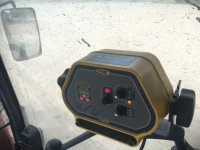Complete Turf Care
Veteran Member
- Joined
- Mar 31, 2013
- Messages
- 2,160
- Location
- South Louisiana
- Tractor
- 2022 Kubota Grand L6060 (no loader), 2017 Kubota Grand L6060, 2011 Kubota L5740 HSTC-3, 1997 Kubota M4700
So basically, the only way you know at any location what the ground is doing is to watch the blade? And then you get a feeling for the lay of the land and come up with a best plan in your head for your movements? Do I have that more or less right?
Yes. But instead of watching the actual blade, I watch the receiver, or the control box in the cab. Both have lights that indicate the blade position relative to the laser beam.
In the picture below you see the green lights, and the red lights below the green. This means the blade needs to be lifted slightly to be 'on grade'. Only red lights mean the blade needs to be lifted more, and only green lights mean the blade is 'on grade'.

